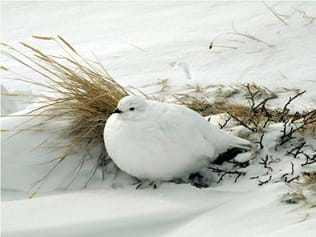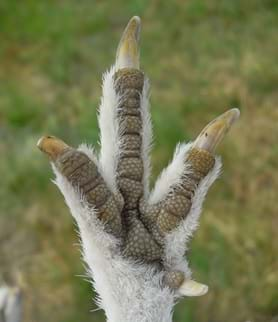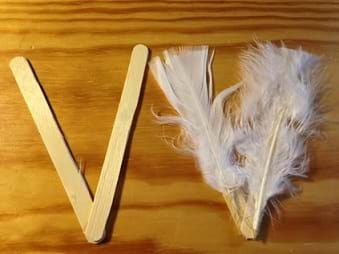Quick Look
Grade Level: Elementary school
Time Required: 1 hour
Expendable Cost: US $1.00
Group Size: 3
Subject Areas: Life Science, Measurement
Introduction
Bolded words are vocabulary and concepts to highlight with students during the activity.
Engineers often design using inspiration from the incredible adaptations of plants and animals in their natural environments—an approach called biomimicry. When engineers and researchers observe an interesting adaptation, such as feather feet on a ptarmigan, they make a hypothesis about the function of the adaptation. The ptarmigan is a chicken-sized bird (see Figure 1) that lives in the tundra and has many amazing adaptions. In the winter, the ptarmigan has a white coat to blend in with the snow and also grows a second layer of feathers to stay warm. Looking at the ptarmigan foot (see Figure 2), how else does it look unusual compared with the feet of other birds/animals? Might the feathers on the ptarmigan feet act like a snowshoe? Today we will investigate whether the feathers have a secondary adaptation—whether the feathers increase floatation like snowshoes do.

Supplies
Each group needs:
- 4 craft sticks
- craft feathers, enough to cover one model foot
- protractor
- 1 blank sheet of paper
For the class to share:
- hot glue
- plastic tub, 12 x 8 x 4 inches (~30 x 20 x 10 cm)
- dried beans, to fill one-third of tub
- scale
Subscribe
Get the inside scoop on all things TeachEngineering such as new site features, curriculum updates, video releases, and more by signing up for our newsletter!Procedure
Procedures Overview
Working in teams of three, students learn about the amazing adaptations of the ptarmigan to the alpine tundra by creating model ptarmigan feet, with and without feathers, and test their hypotheses on the function of the feathers. 
Procedure
- Divide the class into groups of three students each.
- Give the groups a few minutes to talk about and write down their hypotheses about feathers and floatation.
- Then give the groups a few more minutes to discuss how they want to build their model feet: decide what angle to place between "toes" (40° is optimal), how many "toes" and what size, and how to place the feathers on the toes. Note: To maintain a valid experiment, make sure the non-feathered and feathered feet have the same angle.
- Have students build their model feet (see Figure 3). Note: Please provide adult supervision with the hot glue guns since the metal bit on the end of the gun quickly burns skin. Since the hot glue is shared, have each team build the non-feathered foot first and then test while they are waiting to build the next foot.

Figure 3. The two model "feet," without and with feathers. - To test the model feet, first measure the weight of the beans and tub without the model feet and write this on the board. Have students place the model foot on top of the beans. Then, one student evenly pushes down on the end of the V where the sticks connect (the "bottom point" of the V). Record the weight at which the foot "sinks" or becomes submerged in the beans.
- Have groups determine the weight each foot supported: Wsupported= Wto sink - Wof beans
- As a class, create a bar graph of the results for each model foot (with and without feathers) on a chalk/white board and discuss.
Wrap Up - Thought Questions
- What claim can you make from the class results? Did the results match the hypotheses?
- How would you use this observation of nature in real-world engineering applications? How would you apply biomimicry?
- What other examples of biomimicry have you seen?
More Curriculum Like This

Students learn about the amazing adaptations of the ptarmigan to the alpine tundra. They focus on one adaptation, the feathered feet of the ptarmigan, and ask whether the feathers serve to only keep the feet warm or to also provide the bird with floatation capability. They create model ptarmigan fee...
Copyright
© 2013 by Regents of the University of ColoradoLast modified: May 12, 2022






User Comments & Tips